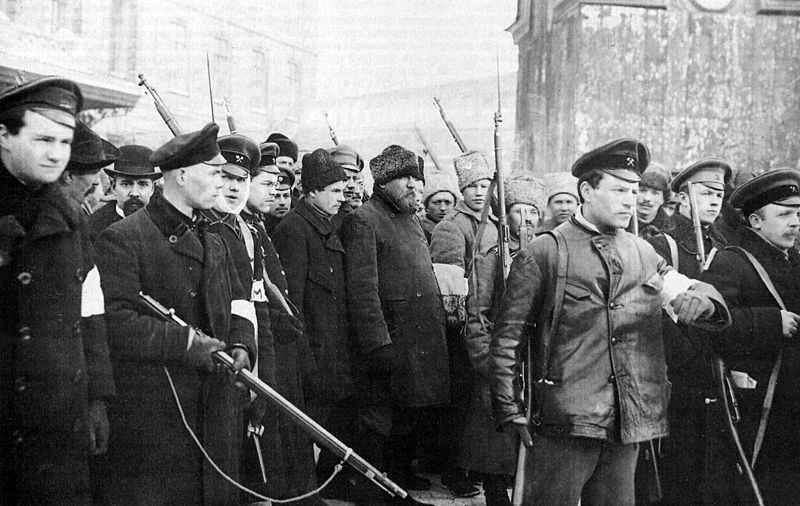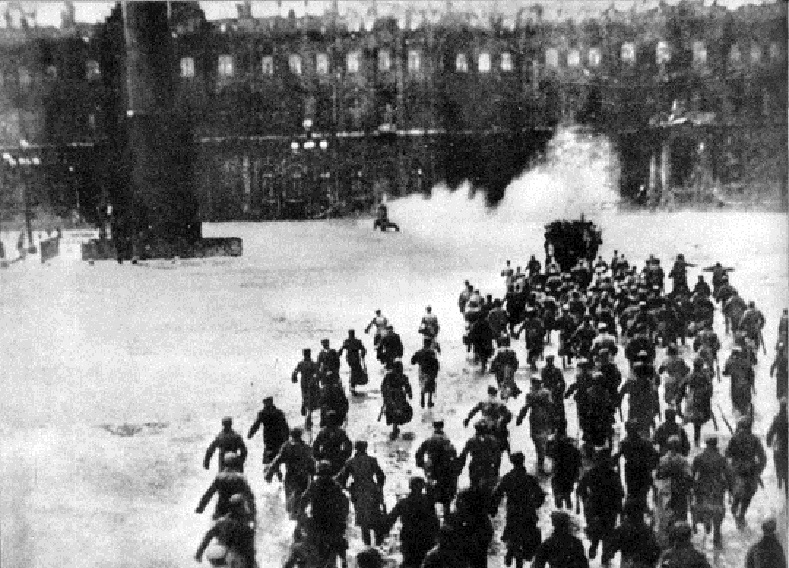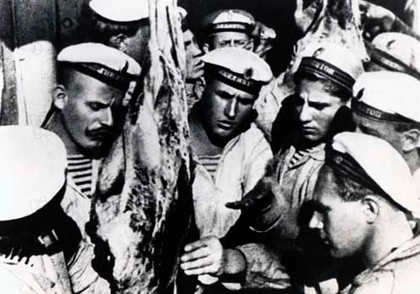By 10am on November 6th, 1917, the soldiers of the Russian Provisional Government in St. Petersburg/Petrograd were taking a break from an already busy morning. Earlier that day, thousands of loyalist troops had fanned out across the capital, seizing a number of newspaper offices – almost all of them Bolshevik-allied – under the charge of inciting insurrection. Printing presses were destroyed, thousands of copies of the morning paper were burned, and arrest warrants were issued for dozens of authors and publishers. Among the arrest warrants were many of the leaders of the Petrograd Soviet, including the body’s newly elected president Leon Trotsky.
The morning’s events were playing out as an almost exact repeat of the Provisional Government’s crackdown against the Bolsheviks during the “July Days” crisis just months earlier. In the course of nearly four months, Prime Minister Alexander Kerensky’s government had outlawed the Bolsheviks, released them when the capital was threatened with a military coup during the Kornilov Affair, and now had gone back to attempting to jail the movement that had dominated the Soviets and was now openly preaching a doctrine of overthrowing the government.
In July, the capital had cheered Kerensky’s strong hand against the agitating Bolsheviks. Now, they seethed with rage that Kerensky appeared to be overthrowing the soldier and worker appointed Soviet. In July, the Bolsheviks had panicked – Lenin had fled the country and many of the movement’s leaders either went underground or froze with inaction. Now, armed with the very weapons Kerensky had given them just a month earlier for a potential defense of St. Petersburg/Petrograd, the Bolsheviks struck back.

Vladimir Lenin address a crowd in St. Petersburg/Petrograd. Lenin was instrumental in pushing the Bolsheviks towards a policy of overthrowing the Provisional Government
If the February Revolution that toppled Tsar Nicholas II had created a political vacuum in the capital, the Kornilov Affair that September had exposed how little that vacuum had been filled by the Provisional Government.
Despite his immense oratory skill and political acumen, Alexander Kerensky had become a leader without followers. Kerensky had risen from the chaos of the initial revolution by securing the support of the delegates of both the Soviet (where he had been elected vice chairman) and the Provisional Government (where he had once been in the Duma). But Kerensky’s unwaivering support for continuing the Great War had slowly robbed him of allies. The Social Revolutionaries (SRs) and Mensheviks who dominated the early Soviets had lost considerable ground for their support of the Provisional Government. By the fall of 1917, the SRs and Mensheviks had lost most of their leadership positions within the Soviet as the Bolsheviks had largely taken over – a process sped up by the release of most of their leadership by Kerensky that September. Even members of the Soviet who had resisted joining the Bolsheviks, like Trotsky, were now willing to ally themselves to the best organized political party in Russia.
For the Petrograd Soviet, and it’s affiliates across the country, the question wasn’t whether or not to seize power, but when and how. Nor was the question a private one – the debate over revolution would be openly discussed, both in formal committees and splashed across the front pages of the capital’s numerous socialist newspapers. The Provisional Government did nothing as they watched their executioners openly debate the date and means of the government’s demise.

The Red Guard – the military wing of the Bolsheviks, the group number 100,000 strong (on paper) and was armed with guns handed to them by the Provisional Government during the Kornilov Affair
Lenin argued the final blow against Kerensky and the Provisional Government had to happen immediately. The longer the Soviet and the Bolsheviks delayed the inevitable, the more time it gave for events on the ground to shift. Kerensky could rally the military and populace to his side – he had before – or he could allow another Kornilov-like general to crush the Soviet. The Germans could also take the capital, doing what the Provisional Government couldn’t or wouldn’t. Some among the Soviet did not agree with Lenin’s conclusions. The SR’s and Mensheviks believed a violent revolution would fail and that the long-promised popularly-elected Constituent Assembly would democratically replace the Provisional Government in time.
Lenin wasn’t interested in leaving the fate of the revolution up for debate. On November 5th, 1917, the Bolshevik Central Committee voted overwhelmingly to support the removal of the Provisional Government. News of the decision, complete with detailed plans of which strategic points the Bolsheviks would occupy, were leaked through the socialist press. With such an obvious call to violence, Kerensky and the government had their pretext to crush the Bolsheviks.

Propaganda pictures of the Red Guard during the Kerensky Counteroffensive – the capital was likely in very little danger as most of the city’s professional soldiers had already sided with the Soviet and/or Bolsheviks. Kerensky had, at best, 700 Cossacks
The Bolshevik call to revolution – and the Provisional Government’s response – had put the Soviet in an unquestionable bind.
By their call to arms, the Bolsheviks had clearly usurped the Soviet’s role as the political leader of the revolution. But the Provisional Government’s crackdown had also targeted a number of the Soviet’s own leadership, since the Bolsheviks and the Soviet were increasingly intertwined. More alarmingly, the Soviet technically controlled the Bolshevik’s military wing, the Red Guards, through the recently created Military Revolutionary Committee – chaired by Leon Trotsky. The Red Guards were already clashing with Provisional Government troops, meaning in essence that a Soviet-controlled militia was at war in the streets with the government. Either the Soviet, and the Military Revolutionary Committee, had to take action, or they risked being made irrelevant, if not outright overthrown themselves by the Bolsheviks or Kerensky’s troops. The Military Revolutionary Committee issued orders to retake the printing houses captured by the Provisional Government, and to seize key installations across the capital. Within a few hours of fighting, the soldiers of the Provisional Government had been driven back and all points of communications – the telegraph lines, roads and railways – were under Soviet and/or Bolshevik control.

A Red Guard blockade group poses for a photo
The formal Bolshevik uprising the following day, on November 7th, was an afterthought by comparison. Five Bolshevik-allied destroyers, complete with Bolshevik-supporting Marines, arrived in St. Petersburg/Petrograd while the city’s formal garrison threw in their lot with the Military Revolutionary Committee. There was more fighting within the Soviet than the city itself. The SR’s and Mensheviks left the Soviet in protest, hoping that if what they deemed was a premature revolution failed, they at least wouldn’t be blamed for it. Even the day’s actual combat was largely for show. The siege of the Winter Palace – former home to the Tsar and now the Provisional Government – lasted longer than necessary, as most of the Palace’s defenders had left that afternoon or now were attempting to surrender. The Bolsheviks would have done of it. Revolutions had to be bloody, or at least look like they were. Although few soldiers on either side were killed or injured, the relentless artillery fire and eventual storming of the Winter Palace destroyed much of the opulence of the former seat of Tsarist power.
As the surviving members of the Provisional Government and it’s garrison surrendered, the Bolsheviks noticed that Alexander Kerensky was not among their newfound prisoners. The Prime Minister had managed to escape via a Renault car from the American embassy and bluff his way past the Red Guard checkpoints. Kerensky would arrive in nearby Pskov, ready to mobilize the Russian army and retake the capital. The revolution was far from settled.

The storming of the Winter Palace – years later. The event was recreated by the Soviets in celebration of Red October. The participants were far larger, and the whole event far shorter, than what actually occurred
“The Provisional Government has been deposed. State power has passed into the hands of the organ of the Petrograd Soviet of Workers’ and Soldiers’ Deputies–the Revolutionary Military Committee, which heads the Petrograd proletariat and the garrison.
The cause for which the people have fought, namely, the immediate offer of a democratic peace, the abolition of landed proprietorship, workers’control over production, and the establishment of Soviet power—this cause has been secured.
Long live the revolution of workers, soldiers and peasants!”
-Revolutionary Military Committee of the Petrograd Soviet of Workers’ and Soldiers’ Deputies
For Lenin, Trotsky and the Bolshevik-allied members of the Soviet, the most immediate concern wasn’t Alexander Kerensky, but their fellow Soviet delegates.
Lenin immediately drafted the above proclamation announcing the overthrow of the Provisional Government, attempting to present the Revolutionary Military Committee as the legitimate heir to the government, and thus, the Bolsheviks as the de facto power in Russia. The Soviet’s SR’s and Mensheviks, still the dominate political factions among the delegates by numbers, walked out as Trotsky, a recent convert to the Bolsheviks, taunted them. “Go where you belong from now on,” Trotsky jeered at the departing delegates, “into the dustbin of history!” Without the SR’s or Mensheviks in attendance, the Soviet quickly adopted a Bolshevik-dominated cabinet. The Soviet remained committed to the promise of a democratically elected Constituent Assembly, but the cabinet’s newly nominated leader, Lenin, had little interest in granting the Assembly authority over the Bolsheviks.

The Soviet Congress – the Bolsheviks were a minority in the body but held many leadership posts
And not without reason – the Petrograd Soviet barely held any control over the vast Russian Empire in the first place. The Mensheviks had seized control in Georgia and declared it an independent state. Fighting across Russia’s urban areas had erupted, favoring the Soviet, but only barely. Most of the countryside was confused at best about the events that had transpired in St. Petersburg/Petrograd, and openly hostile to the Bolsheviks at worst. Some on the left immediately criticized the Bolsheviks, claiming they had “betrayed” the revolution by claiming power for themselves.
Into the chaos rode Kerensky – literally, as he rode a white horse while leading a contingent of 700 Cossacks to retake the capital. Kerensky and his allies were proclaiming that he was “saving” the revolution, but faced extremely long odds towards driving the Bolsheviks out. The Red Guards had 100,000 men in St. Petersburg/Petrograd, to say nothing of the city’s military garrison. Kerensky believed he could put his golden tongue to work once again and rally soldiers to his side. Some would. Roughly 1,000 military cadets within the capital rose up against the Red Guards, successfully disarming many of them and retaking a few key positions within the city. But the “mutiny” of these borderline child soldiers, who called themselves the “Salvation Army,” went little further than that. The Bolshevik-backed garrison of the capital had no intention of taking orders from a bunch of “junkers” (young lords or noblemen) and the Salvation Army folded with relatively little fighting.

Russian sailors in St. Petersburg/Petrograd. The naval shelling of Provisional Government positions was heavily played for propaganda
As Kerensky’s forces approached the capital, the former Prime Minister found little more success than the Salvation Army had. Many average soldiers were unsure who – if anyone – to support in this latest revolution. Kerensky and his largely Cossack-backed force had encountered little active resistance but also little support. Near the capital, Kerensky attempted to force a group of soldiers to lay down their weapons. When they didn’t comply, the Cossacks opened fire. For a conflict that had consumed lives on a horrific scale, the day’s casualties were a blip in the historical record. But the action robbed Kerensky of the last of his credibility. The talented leftist orator had gone from revolutionary to dictator in a matter of months. His haphazard attempt to retake the capital would end almost as soon as it began.
Shortly after his defeat, Kerensky would abandon Russia, preferring exile to supporting either the Bolsheviks or the “White Army” coalition of military and royalists that fought in the Russian Civil War. The former Prime Minister would settle in America, teaching classes at the Hoover Institution in California in-between serving in an honorary capacity on several New York-based think tanks. The October Revolution would define him, as he sought to repackage his brief stint in power as Russia’s sole flirtation with democracy between the tyrannies of the Tsar and the Soviets. Kerensky would not even find solace in death – his burial in an Russian Orthodox Church in New York was prevented as the church bore him largely responsible for the Bolshevik rise to power.
By the middle of November of 1917, the defining events of “Red October” (named as the events took place in October by the Tsarist era Julian calendar) had ended with the Bolsheviks in power, albeit barely. They wasted no time in fulfilling their revolutionary promises.

Pictures from Russia’s future – survivors of one of the many battles of the Russian Civil War pose with the dead, a mixture of Soviets and White Army troops
The Bolsheviks announced they would exit the Great War, agreeing to an exceedingly temporary armistice with Germany in December. Unlike the Provisional Government, the Bolsheviks held no concern over the financial strings that had tied them to the Allies. Debts would be ignored and secret communications, like the Sykes-Picot Agreement, would be released to the world public. For all their talk of revolution, the early Soviets had still envisioned a world structured on similar terms to those of the Allies, buttressed by societal, financial and diplomatic norms of the era. The Bolsheviks’ world view recognized none of it. And there would endless pools of blood needed still to be shed to realize the vision unleashed by Russia’s Red October.

Just think what a single, skilled sniper could have accomplished in St. Petersburg.
Avert a massacre that dwarfed all others, and perhaps, saved generations of American children from growing up to be cultural tapeworms.
Pingback: Black & White & Reds All Over | Shot in the Dark